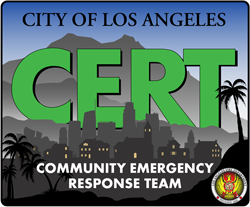CERT Flashcards
Unit 4 – Medical Part 2
Determine, as clearly as possible, the extent of injuries
Determine what type of treatment is needed
Document injuries
Remember to always wear your safety equipment when conducting head-to-toe assessments.
In a safe area that is close to, but uphill, upwind, and, if possible, upstream from the hazard area
Accessible by transportation vehicles
Expandable
Anatomical splints are usually reserved for fingers and toes, but, in an emergency, legs may also be splinted together.
Soft materials should be used to fill the gap between the splinting material and the body part.
With this type of injury, there will be swelling. Remove restrictive clothing, shoes, and jewelry when necessary to prevent these items from acting as unintended tourniquets.
The use of other solutions (e.g., hydrogen peroxide) on wounds must be the decision of trained medical personnel.
Control bleeding
Clean the wound
Apply dressing and bandage
Tenderness at the site of the injury
Swelling and/or bruising
Restricted use or loss of use
Name, address, and phone number if victim is able to talk
Description (age, sex, body build, estimated height)
Clothing
Injuries
Treatment
Transfer location
Verbal communication between workers in the treatment areas
Shared access to medical supplies (which should be cached in a central location)
Easy transfer of patients whose status has changed victims who have been identified with minor injuries may choose to stay at the treatment area or leave.
If they stay, they can assist CERT personnel. If they leave, it should be documented.
Maintaining proper hygiene
Maintaining proper sanitation
Purifying water (if necessary)
Preventing the spread of disease
In the absence of active bleeding, dressings must be removed and the wound checked for infection at least every 4 to 6 hours.
If there is active bleeding, a new dressing should be placed over the existing dressingWhenever possible, a dressing should be sterile.
A bandage holds the dressing in place.
If a wound is still bleeding, the bandage should place enough pressure on the wound to help control bleeding without interfering with circulation.
If the limb is angled, then there is a displaced fracture.
When a foreign object is impaled in a patient’s body, you should:
Immobilize the affected body part
Not attempt to move or remove the object, unless it is obstructing the airway
Try to control bleeding at the entrance wound without placing undue pressure on the foreign object
Clean and dress the wound making sure to stabilize the impaled object. Wrap bulky dressings around the object to keep it from moving.
Control bleeding
Treat shock
When the severed body part can be located, CERT members should:
Save tissue parts, wrapped in clean material and placed in a plastic bag, if available. Label them with the date, time, and victim’s name.
Keep the tissue parts cool, but NOT in direct contact with ice
Keep the severed part with the victim
Triage – The initial assessment and sorting of victims for treatment based on the severity of their injuries
Treatment – The disaster medical services provided to victims
Transport – The movement of victims from incident location to the treatment area
Morgue – The temporary holding area for victims who have died at the treatment area. Those who are tagged as “Dead” during triage are not removed from the incident site.
Supply – The hub for crucial supply procurement and distribution
CERT medical operations personnel can maintain sanitary conditions by:
Controlling the disposal of bacterial sources (e.g., soiled exam gloves, dressings, etc.)
Putting waste products in plastic bags, tying off the bags, and marking them as medical waste. Keep medical waste separate from other trash, and dispose of it as hazardous waste.
Burying human waste. Select a burial site away from the operations area and mark the burial site for later cleanup.
When treating an open fracture:
Do not draw the exposed bone ends back into the tissue.
Do not irrigate the wound. You should:
Cover the wound with a sterile dressing
Splint the fracture without disturbing the wound
Place a moist 4 by 4-inch dressing over the bone end to keep it from drying out
First aid treatment for closed fractures may require only splinting.
First-degree (superficial) burns. First-degree burns affect only the epidermis, or outer layer of skin. The burn site is red, painful, dry, and with no blisters. Mild sunburn is an example. Long-term tissue damage is rare and usually consists of an increase or decrease in the skin color.
Second-degree (partial thickness) burns. Second-degree burns involve the epidermis and part of the dermis layer of skin. The burn site appears red, blistered, and may be swollen and painful.
Third-degree (full thickness) burns. Third-degree burns destroy the epidermis and dermis and may go into the subcutaneous tissue. The burn site may appear white or charred.
Treatment for burns involves removing the source of the burn, cooling the burn, and covering it.For full thickness burns, always treat for shock.Conducted on all victims, even those who seem all right
Verbal (if the patient is able to speak)
Hands-on. Do not be afraid to remove clothing to look.
Determining the best location(s) for the CERT treatment area should include the following overall considerations:
Safety for rescuers and victims
Most effective use of resources, e.g., CERT members themselves, time, medical supplies
Swelling around the wound site
Discoloration
Discharge from the wound
Red striations from the wound site
Effective use of space
Effective use of available personnel.
As a team member finishes one head-to-toe assessment, he or she turns around and is at the head of the next patient.
DCAP-BTLS stands for the following:
Deformities
Contusions (bruising)
Abrasions
Punctures
Burns
Tenderness
Lacerations
Swelling
When conducting a head-to-toe assessment, CERT members should look for DCAP-BTLS in all parts of the body.
Remember to provide IMMEDIATE treatment for life-threatening injuries.
You should pay careful attention to how people have been hurt (the mechanism of injury) because it provides insight to probable injuries suffered.

